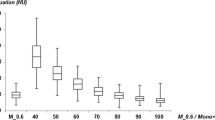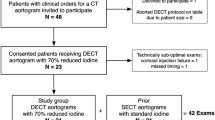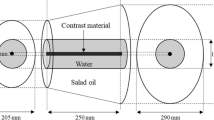Abstract
Objectives
To assess image quality of virtual monochromatic spectral (VMS) images, compared to single-energy (SE) CT, and to evaluate the feasibility of material density imaging in abdominal aortic disease.
Methods
In this retrospective study, single-source (ss) dual-energy (DE) CT of the aorto-iliac system in 35 patients (32 male, mean age 76.5 years) was compared to SE-CT. By post-processing the data from ssDECT, VMS images at different energies and material density water (WD) images were generated. The image quality parameters were rated on 5-point scales. The aorto-iliac attenuation and contrast-to-noise ratio (CNR) were recorded. Quality of WD images was compared to true unenhanced (TNE) images. Radiation dose was recorded and statistical analysis was performed.
Results
Image quality and noise were better at 70 keV (P < 0.01). Renal artery branch visualisation was better at 50 keV (P < 0.005). Attenuation and CNR were higher at 50 and 70 keV (P < 0.0001). The WD images had diagnostic quality but higher noise than TNE images (P < 0.0001). Radiation dose was lower using single-phase ssDECT compared to dual-phase SE-CT (P < 0.0001).
Conclusion
70-keV images from ssDECT provide higher contrast enhancement and improved image quality for aorto-iliac CT when compared to SE-CT at 120 kVp. WD images are an effective substitute for TNE images with a potential for dose reduction.
Key Points
• Multi-detector computed tomography (MDCT) angiography is now a routine procedure.
• Single-source dual-energy CT (ssDECT) can provide simultaneous data with different kilovoltages.
• 70 keV images showed better image quality than conventional single-energy (SE) CT.
• 70 keV images exhibited less image noise in comparison to SE-CT.





Similar content being viewed by others
References
Görich J, Rilinger N, Sokiranski R et al (2001) Endoleaks after endovascular repair of aortic aneurysm: are they predictable? Initial results. Radiology 218:477–480
Armerding MD, Rubin GD, Beaulieu CF et al (2000) Aortic aneurysmal disease: assessment of stent-graft treatment-CT versus conventional angiography. Radiology 215:138–146
Chao CP, Walker TG, Kalva SP (2009) Natural history and CT appearances of aortic intramural hematoma. Radiographics 29:791–804
Hayashi H, Matsuoka Y, Sakamoto I et al (2000) Penetrating atherosclerotic ulcer of the aorta: imaging features and disease concept. Radiographics 20:995–1005
Pipitone N, Versari A, Salvarani C (2008) Role of imaging studies in the diagnosis and follow-up of large-vessel vasculitis: an update. Rheumatology (Oxford) 47:403–408
Chung JW, Kim H-C, Choi YH, Kim SJ, Lee W, Park JH (2007) Patterns of aortic involvement in Takayasu arteritis and its clinical implications: evaluation with spiral computed tomography angiography. J Vasc Surg 45:906–914
Kertesz JL, Anderson SW, Murakami AM, Pieroni S, Rhea JT, Soto JA (2009) Detection of vascular injuries in patients with blunt pelvic trauma by using 64-channel multidetector CT. Radiographics 29:151–164
Tanikake M, Shimizu T, Narabayashi I et al (2003) Three-dimensional CT angiography of the hepatic artery: use of multi-detector row helical CT and a contrast agent. Radiology 227:883–889
Rubin GD, Schmidt AJ, Logan LJ, Sofilos MC (2001) Multi-detector row CT angiography of lower extremity arterial inflow and runoff: initial experience. Radiology 221:146–158
Rubin GD, Shiau MC, Leung AN, Kee ST, Logan LJ, Sofilos MC (2000) Aorta and iliac arteries: single versus multiple detector-row helical CT angiography. Radiology 215:670–676
Alvarez RE, Macovski A (1976) Energy-selective reconstructions in X-ray computerized tomography. Phys Med Biol 21:733–744
Johnson TRC, Krauss B, Sedlmair M et al (2007) Material differentiation by dual energy CT: initial experience. Eur Radiol 17:1510–1517
Flohr TG, McCollough CH, Bruder H et al (2006) First performance evaluation of a dual-source CT (DSCT) system. Eur Radiol 16:256–268
Graser A, Johnson TRC, Chandarana H, Macari M (2009) Dual energy CT: preliminary observations and potential clinical applications in the abdomen. Eur Radiol 19:13–23
Wintermark M, Maeder P, Verdun FR et al (2000) Using 80 kVp versus 120 kVp in perfusion CT measurement of regional cerebral blood flow. AJNR Am J Neuroradiol 21:1881–1884
Wintersperger B, Jakobs T, Herzog P et al (2005) Aorto-iliac multidetector-row CT angiography with low kV settings: improved vessel enhancement and simultaneous reduction of radiation dose. Eur Radiol 15:334–341
Nakayama Y, Awai K, Funama Y et al (2006) Lower tube voltage reduces contrast material and radiation doses on 16-MDCT aortography. AJR Am J Roentgenol 187:W490–W497
Sigal-Cinqualbre AB, Hennequin R, Abada HT, Chen X, Paul J-F (2004) Low-kilovoltage multi-detector row chest CT in adults: feasibility and effect on image quality and iodine dose. Radiology 231:169–174
Chandarana H, Godoy MCB, Vlahos I et al (2008) Abdominal aorta: evaluation with dual-source dual-energy multidetector CT after endovascular repair of aneurysms–initial observations. Radiology 249:692–700
Okayama S, Seno A, Soeda T et al (2011) Optimization of energy level for coronary angiography with dual-energy and dual-source computed tomography. Int J Cardiovasc Imaging. doi:10.1007/s10554-011-9897-z
Ascenti G, Mazziotti S, Lamberto S et al (2011) Dual-energy CT for detection of endoleaks after endovascular abdominal aneurysm repair: usefulness of colored iodine overlay. AJR Am J Roentgenol 196:1408–1414
Thomas C, Korn A, Ketelsen D et al (2010) Automatic lumen segmentation in calcified plaques: dual-energy CT versus standard reconstructions in comparison with digital subtraction angiography. AJR Am J Roentgenol 194:1590–1595
Sommer WH, Graser A, Becker CR et al (2010) Image quality of virtual noncontrast images derived from dual-energy CT angiography after endovascular aneurysm repair. J Vasc Interv Radiol 21:315–321
Stolzmann P, Frauenfelder T, Pfammatter T et al (2008) Endoleaks after endovascular abdominal aortic aneurysm repair: detection with dual-energy dual-source CT. Radiology 249:682–691
Matsumoto K, Jinzaki M, Tanami Y, Ueno A, Yamada M, Kuribayashi S (2011) Virtual monochromatic spectral imaging with fast kilovoltage switching: improved image quality as compared with that obtained with conventional 120-kVp CT. Radiology 259:257–262
Rau MM, Setty BN, Blake MA, Ouellette-Piazzo K, Hahn PF, Sahani DV (2007) Evaluation of renal transplant donors with 16-section multidetector CT angiography: comparison of contrast media with low and high iodine concentrations. J Vasc Interv Radiol 18:603–609
Godoy MCB, Naidich DP, Marchiori E et al (2010) Single-acquisition dual-energy multidetector computed tomography: analysis of vascular enhancement and postprocessing techniques for evaluating the thoracic aorta. J Comput Assist Tomogr 34:670–677
Huda W, Scalzetti EM, Levin G (2000) Technique factors and image quality as functions of patient weight at abdominal CT. Radiology 217:430–435
Kalender WA, Perman WH, Vetter JR, Klotz E (1986) Evaluation of a prototype dual-energy computed tomographic apparatus. I. Phantom studies. Med Phys 13:334–339
Kalva SP, Sahani DV, Hahn PF, Saini S (2006) Using the K-edge to improve contrast conspicuity and to lower radiation dose with a 16-MDCT: a phantom and human study. J Comput Assist Tomogr 30:391–397
Acknowledgements
DVS has received grant support from GE Healthcare in the past but not related to this study.
Author information
Authors and Affiliations
Corresponding author
Rights and permissions
About this article
Cite this article
Pinho, D.F., Kulkarni, N.M., Krishnaraj, A. et al. Initial experience with single-source dual-energy CT abdominal angiography and comparison with single-energy CT angiography: image quality, enhancement, diagnosis and radiation dose. Eur Radiol 23, 351–359 (2013). https://doi.org/10.1007/s00330-012-2624-x
Received:
Revised:
Accepted:
Published:
Issue Date:
DOI: https://doi.org/10.1007/s00330-012-2624-x




